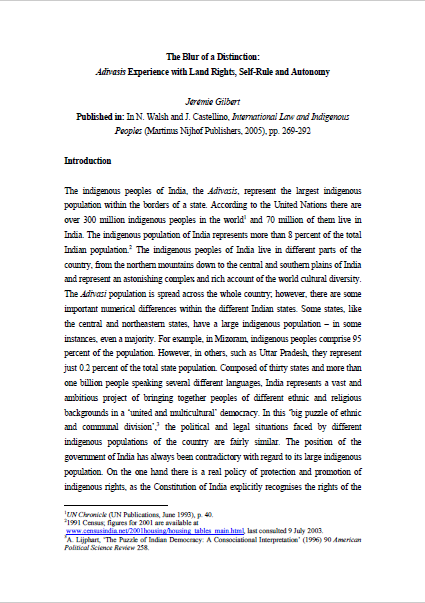Empirical Study on Compatibility of Sarawak Forest Ordinance and Bidayuh Native Customary Laws in Forest Management
This study was conducted to examine the compatibility between the Sarawak Forest Ordinance and Bidayuh Native Customary Laws in Sarawak and to gather the community membersâ opinions on the compatibility of these laws. This study was carried out using two research methods, viz. a literature review and a survey among the Bidayuh community in Bau, Sarawak. The documents reviewed were the Forest Ordinance Chapter 126 (1958) and the Adat Bidayuh Order, 1994.
REDD+, transparency, participation and resource rights: the role of law
One of the crucial questions which emerges in the context of REDD+ is how the rights of indigenous peoples and local communities will be protected. These rights include the rights of sharing in the financial benefits of REDD+, the rights to participate in decision-making around REDD+ schemes, and the rights to have their knowledge about forestry resources respected. Each of these issues depends on the extent to which they have some sort of claim to, or tenure over, tropical rainforests.
‘Caring for country’: a review of Aboriginal engagement in environmental management in New South Wales
This article discusses some emerging models of Indigenous engagement in environmental management in New South Wales and urges expansion of such engagement. NSW Aboriginal people own only around one per cent of the state's land, which suggests that land ownership and rights-based approaches to Aboriginal participation in environmental management are insufficient in NSW. Alternative approaches that recognise Aboriginal responsibilities to ‘care for country’ are needed.
Participatory mapping to identify indigenous community use zones: Implications for conservation planning in southern Suriname
Large-scale development projects often overlap forest areas that support the livelihoods of indigenous peoples, threatening in situ conservation strategies for the protection of biological and cultural diversity. To address this problem, there is a need to integrate spatially-explicit information on ecosystem services into conservation planning. We present an approach for identifying conservation areas necessary to safeguard the provision of important ecosystem services for indigenous communities.
Traditional Knowledge and Management of Umbu (Spondias tuberosa, Anacardiaceae): An Endemic Species from the Semi–Arid Region of Northeastern Brazil
satellite analysis of contrasting fire patterns in Aboriginal- and Euro-Australian lands in tropical North Australia
We use satellite imagery to compare and contrast fire patterns across a repeating mosaic of vegetation types occurring within the tropical savanna of the Northern Territory, Australia. Our study area included different land management settings that encapsulate three contrasting styles of management that have developed following European settlement in northern Australia: Decentralized fire management carried out by small Aboriginal communities widely dispersed across a large landscape.
Traditional Knowledge and Useful Plant Richness in the Tehuacán–Cuicatlán Valley, Mexico
Productive Diversification and Sustainable Use of Complex Social-Ecological Systems: A Comparative Study of Indigenous and Settler Communities in the Bolivian Amazon
Agricultural and forest productive diversification depends on multiple socioeconomic drivers—like knowledge, migration, productive capacity, and market—that shape productive strategies and influence their ecological impacts. Our comparison of indigenous and settlers allows a better understanding of how societies develop different diversification strategies in similar ecological contexts and how the related socioeconomic aspects of diversification are associated with land cover change.
Socio-economic issues in forest management in India
India's forest policy regime enacted so far had alienated the common users of their property rights in the name of forest and wildlife conservation. However, poor conservation outcomes have forced planners to reconsider the role of the forest community in resource use and conservation. Presence of a deep-rooted economic, social, cultural and ethical difference between members of Forest Protection Committee (FPC) constrains group behaviour and their capacity to modify regulations governing resource use.
The Blur of a Distinction: Adivasis Experience with Land Rights, Self-Rule and Autonomy
This article was published in a book International Law and Indigenous Peoples edited by J. Castellino & N. Walsh.


